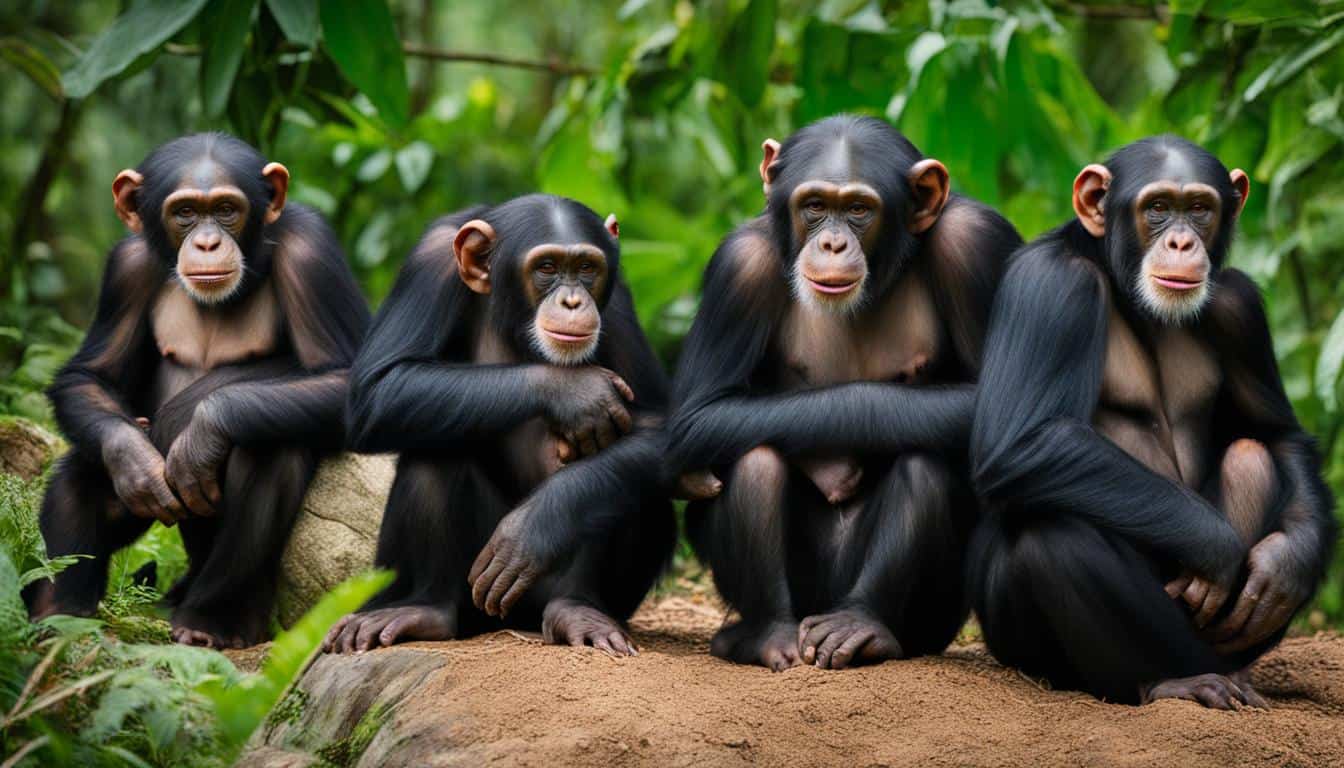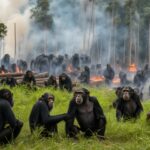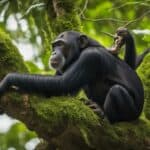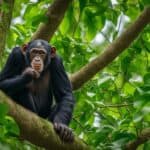When it comes to the incredible world of primates, chimpanzees are among the most fascinating. These intelligent and social beings are native to the forests and savannahs of tropical Africa. Did you know that there are actually different species of chimpanzees, each with its own unique characteristics and distinctions?
Let’s delve into the world of chimpanzee classification and explore the types of chimpanzees that inhabit our planet. By understanding the different species and their distinctions, we can gain a deeper appreciation for the remarkable diversity within the chimpanzee family.
Central Chimpanzee (Pan troglodytes troglodytes)
The Central chimpanzee, also known as Pan troglodytes troglodytes, is one of the subspecies of the common chimpanzee. This subspecies is primarily found in the savanna woodlands, tropical moist forests, and forest-savanna mosaics of Cameroon, Central African Republic, Gabon, Republic of the Congo, Equatorial Guinea, the Democratic Republic of the Congo, and other countries in the region.
Distinguished by its more robust build compared to other chimpanzee subspecies, the Central chimpanzee plays a crucial role in maintaining the biodiversity of its habitat. Unfortunately, the Central chimpanzee is listed as endangered by the International Union for Conservation of Nature (IUCN) due to habitat destruction and other threats. It is estimated that there are only around 47,000 to 78,000 individuals of this species remaining in the wild, underscoring the urgent need for conservation efforts to protect and preserve these magnificent creatures.
“The Central chimpanzee, Pan troglodytes troglodytes, is a subspecies of the common chimpanzee primarily found in the woodlands and forests of Central Africa. Its robust build and endangered status highlight the importance of conservation efforts to protect this unique and vulnerable species.”
Western Chimpanzee (Pan troglodytes verus)
The Western chimpanzee, scientifically known as Pan troglodytes verus, is a subspecies of the common chimpanzee found primarily in Guinea and Côte d’Ivoire, with smaller populations in other West African countries. These chimpanzees have distinct characteristics and behaviors that set them apart from other subspecies.
One notable behavior of the Western chimpanzee is their utilization of wooden spears for hunting. They are skilled at crafting and using tools, which demonstrates their advanced cognitive abilities. Additionally, they have been observed building cave-like structures as homes, providing protection from the elements and potential predators.
Western chimpanzees are highly social animals and live in complex social groups. They form strong bonds, communicate through vocalizations and gestures, and exhibit intricate social hierarchies. These social connections are crucial for their survival and play a significant role in their daily lives.
Despite their remarkable adaptability, Western chimpanzees face numerous threats to their existence. Habitat loss due to deforestation, illegal hunting for bushmeat, and the ongoing human-wildlife conflict have resulted in their endangered status. It is estimated that there are only around 21,300 to 55,600 Western chimpanzees remaining in Africa, emphasizing the urgent need for conservation efforts.
To provide a visual representation, here is a table summarizing key information about the Western chimpanzee:
| Scientific Name | Pan troglodytes verus |
|---|---|
| Common Name | Western chimpanzee |
| Native Range | Guinea, Côte d’Ivoire, and other West African countries |
| Distinct Behaviors | Tool usage (wooden spears), cave-like homes |
| Conservation Status | Endangered |
| Population | Approximately 21,300 to 55,600 individuals |
Through understanding and efforts to protect the Western chimpanzees and their unique behaviors, we can contribute to the preservation of these remarkable creatures and the biodiversity of our planet.

Nigeria-Cameroon Chimpanzee (Pan troglodytes ellioti)
The Nigeria-Cameroon chimpanzee, also known as Pan troglodytes ellioti, is a subspecies of the common chimpanzee that inhabits the rainforests of Nigeria and Cameroon. This subspecies is the most threatened among the other subspecies of common chimpanzees due to its narrow range of distribution. Male members of the Nigeria-Cameroon chimpanzee can grow up to 70 kilograms and reach a body length of nearly 1.2 meters. This subspecies is facing significant threats from habitat destruction and human activities, and concerted efforts are needed to ensure its survival.
https://www.youtube.com/watch?v=TeO63TUb6w4
Eastern Chimpanzee (Pan troglodytes schweinfurthii)
The Eastern chimpanzee, scientifically known as Pan troglodytes schweinfurthii, is a subspecies of the common chimpanzee. It is primarily found in countries across East Africa, including Burundi, Rwanda, Tanzania, Uganda, South Sudan, the Democratic Republic of the Congo, and the Central African Republic.
This particular subspecies has garnered significant attention and research from esteemed primatologist Dr. Jane Goodall, who conducted extensive studies on the Eastern chimpanzees at Gombe National Park. Through her work, valuable insights have been gained into the behavior, communication, and social dynamics of these remarkable animals.
Unfortunately, the Eastern chimpanzee is facing numerous threats to its survival. Habitat loss due to deforestation, as well as the spread of contagious diseases from humans, are major challenges in preserving their population. As a result, the IUCN has classified the Eastern chimpanzee as an endangered species.
Current estimates suggest that there are approximately 180,000 to 256,000 Eastern chimpanzees remaining in the wild. Efforts from conservation organizations, researchers, and local communities are crucial for protecting their habitat and ensuring the long-term survival of this subspecies.
How do the Unique Physical Features of Chimpanzees Differ Among Different Species?
Different species of chimpanzees have unique physical features chimpanzees that set them apart from one another. For example, bonobos have longer legs and a more slender build compared to other chimps. Meanwhile, common chimpanzees have larger heads and longer arms, giving them distinct physical characteristics.
What are the Distinctive Characteristics of Chimpanzees Compared to Gorillas?
Chimpanzees and different species of gorillas have distinct characteristics. Chimpanzees are smaller and more agile, with longer arms and a tendency to walk on all fours. Gorillas, on the other hand, are larger and more robust, with a tendency to walk on their knuckles. Both species have their own unique social structures and behavior patterns.







